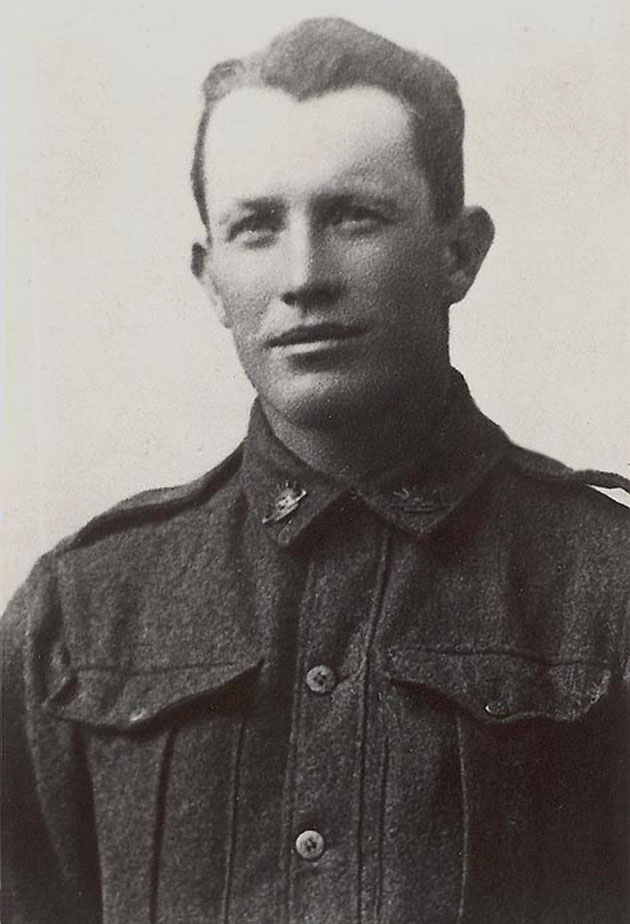Pte
Daniel Maye
Information about birth
|
Date of birth: 29/11/1888 |
|
Place of birth: Brisbane, Queensland, Australia |
General information
|
Profession: Day laborer |
Army information
|
Country: Australia |
|
Force: Australian Imperial Force |
|
Rank: Private |
|
Service number: 470 |
|
Enlistment date: 10/04/1915 |
|
Enlistment place: At sea |
|
Units: — Australian Infantry, 26th Bn. (Queensland and Tasmania) (Last known unit) |
Information about death
|
Date of death: 05/10/1917 |
|
Place of death: Zonnebeke, Belgium |
|
Cause of death: Killed in action (K.I.A.) |
|
Age: 28 |
Memorial
|
Ypres (Menin Gate) Memorial Panel: 23 |
Distinctions and medals 3
|
1914-15 Star Medal |
|
British War Medal Medal |
|
Victory Medal Medal |
Points of interest 2
| #1 | Place of birth | ||
| #2 | Place of death (approximate) |
My story
Daniel Maye, born in Brisbane, Queensland in 1888, enlisted in the Australian Imperial Force in September 1915. Daniel enlisted at sea. At the time he was working as a labourer in North Tumbulgum, New South Wales. He left for Gallipoli and was hospitalised and treated for numerous diseases. In March 1916 his unit arrived in France. On the 28th of July 1916 he sustained a gunshot wound to his right arm and was transferred to the Western General Hospital in Manchester. After his recovery he was posted to 1st ANZAC light railway in January 1917. On the 12th of June 1917 he re-joined his original unit. “B” Company, 26th Battalion Australian Infantry (Queensland and Tasmania), part of the 7th Brigade, 2nd Australian Division. After the Battle of Arras the Division moved to Flanders to participate in the Battle of Passchendaele. On the 4th and 5th of October 1917, the Division passed through Zonnebeke. It prepared itself for the Battle of Broodseinde, a phase of the offensive.
The 2nd Australian Division attacked at 5.25 a.m., with two brigades. The 7th brigade was on the left, the 6th on the right. The advance of the 7th Brigade was carried by the 25th and 26th Battalions. The 25th Battalion was to capture and consolidate the first objective near Thames Wood and Moulin Farm. Once the line had been secured, the 26th Battalion was to leapfrog the 25th and was to capture the final objective on the Broodseinde Ridge.
At the advance of the attack, a German counter-attack had to be fought off. The 6th Australian Brigade captured Zonnebeke village, including the hamlet of Broodseinde. The 7th Australian Brigade cleared Zonnebeke village of snipers. The 26th Battalion was heavily shelled, while moving through Zonnebeke. This resulted in a number of casualties. After the consolidation of the first objective, the 26th Battalion advanced. They met little opposition, until they reached the Broodseinde ridge. Here they faced severe fire from German machine-guns positioned in Daisy Wood, some 300 yards away. It was decided to consolidate a line in an old British trench from 1914-1915, 200 yards short of the objective.
Daniel Maye, 28, went missing during the attack. He was later reported to have been killed in action, on October 5th 1917. An eye witness in Daniel’s Red Cross Wounded and Missing Files stated that he had seen Daniel’s dead body lying between the support line and the reserve line on October 4th 1917. Till this day Daniel has no known grave and is remembered on the Ypres (Menin Gate) Memorial.
The 2nd Australian Division attacked at 5.25 a.m., with two brigades. The 7th brigade was on the left, the 6th on the right. The advance of the 7th Brigade was carried by the 25th and 26th Battalions. The 25th Battalion was to capture and consolidate the first objective near Thames Wood and Moulin Farm. Once the line had been secured, the 26th Battalion was to leapfrog the 25th and was to capture the final objective on the Broodseinde Ridge.
At the advance of the attack, a German counter-attack had to be fought off. The 6th Australian Brigade captured Zonnebeke village, including the hamlet of Broodseinde. The 7th Australian Brigade cleared Zonnebeke village of snipers. The 26th Battalion was heavily shelled, while moving through Zonnebeke. This resulted in a number of casualties. After the consolidation of the first objective, the 26th Battalion advanced. They met little opposition, until they reached the Broodseinde ridge. Here they faced severe fire from German machine-guns positioned in Daisy Wood, some 300 yards away. It was decided to consolidate a line in an old British trench from 1914-1915, 200 yards short of the objective.
Daniel Maye, 28, went missing during the attack. He was later reported to have been killed in action, on October 5th 1917. An eye witness in Daniel’s Red Cross Wounded and Missing Files stated that he had seen Daniel’s dead body lying between the support line and the reserve line on October 4th 1917. Till this day Daniel has no known grave and is remembered on the Ypres (Menin Gate) Memorial.
Sources 8
|
Brigade Diary https://www.awm.gov.au/collection/C1346531 Sources used |
|
CGWC https://www.cwgc.org/find-war-dead/casualty/1599655/maye,-daniel/ Sources used |
|
McCarthy C., The Third Ypres Passchendaele. The Day-by-Day Account, London, Arms & Armour Press, 1995, pg. 99 Sources used |
|
Red Cross Wounded and Missing File https://www.awm.gov.au/advanced-search/people?people_preferred_name=daniel+maye&people_service_number=470&people_unit= Sources used |
|
Service Record https://recordsearch.naa.gov.au/SearchNRetrieve/Interface/DetailsReports/ItemDetail.aspx?Barcode=8215945&isAv=N Sources used |
|
The AIF-Project https://www.aif.adfa.edu.au/showPerson?pid=192222 Sources used |
|
The Long Long Trail https://www.longlongtrail.co.uk/ Sources used |
|
War Diary https://www.awm.gov.au/collection/C1343387 Sources used |
